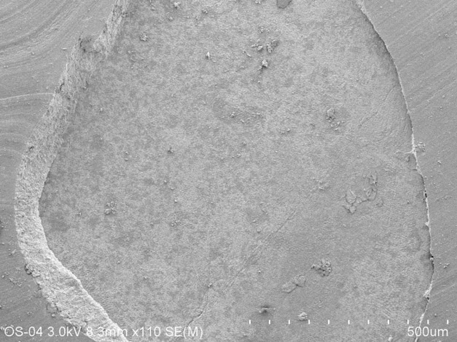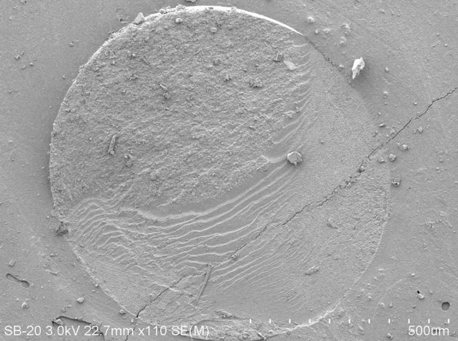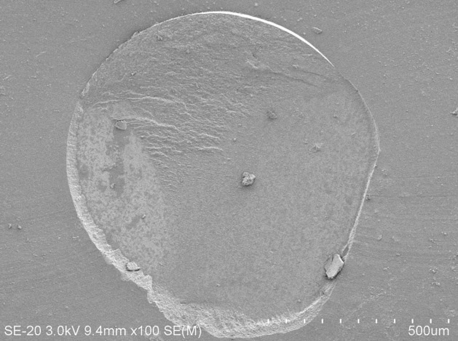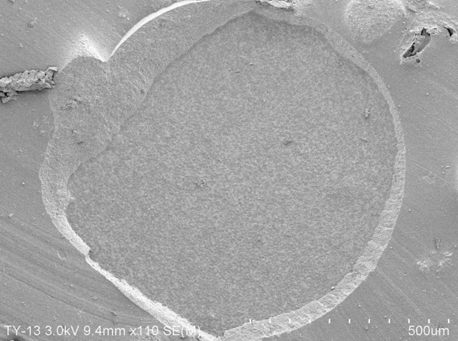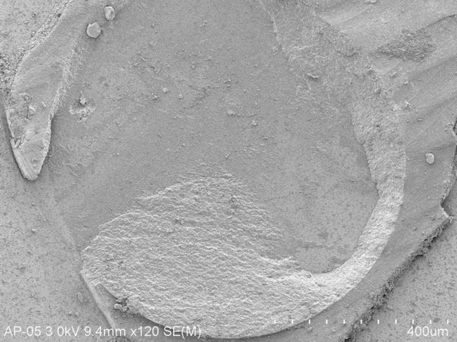J Korean Acad Conserv Dent.
2011 Jan;36(1):50-58. 10.5395/JKACD.2011.36.1.50.
Microshear bond strength of a flowable resin to enamel according to the different adhesive systems
- Affiliations
-
- 1Department of Conservative Dentistry, Chosun University School of Dentistry, Gwangju, Korea. ygcho@mail.chosun.ac.kr
- KMID: 1446083
- DOI: http://doi.org/10.5395/JKACD.2011.36.1.50
Abstract
OBJECTIVES
The purpose of this study was to compare the microshear bond strength (uSBS) of two total-etch and four self-etch adhesive systems and a flowable resin to enamel.
MATERIALS AND METHODS
Enamels of sixty human molars were used. They were divided into one of six equal groups (n = 10) by adhesives used; OS group (One-Step Plus), SB group (Single Bond), CE group (Clearfil SE Bond), TY group (Tyrian SPE/One-Step Plus), AP group (Adper Prompt L-Pop) and GB group (G-Bond). After enamel surfaces were treated with six adhesive systems, a flowable composite resin (Filek Z 350) was bonded to enamel surface using Tygon tubes. the bonded specimens were subjected to uSBS testing and the failure modes of each group were observed under FE-SEM.
RESULTS
1. The uSBS of SB group was statistically higher than that of all other groups, and the uSBS of OS, SE and AP group was statistically higher than that of TY and GB group (p < 0.05). 2. The uSBS for TY group was statistically higher than that for GB group (p < 0.05). 3. Adhesive failures in TY and GB group and mixed failures in SB group and SE group were often analysed. One cohesive failure was observed in OS, SB, SE and AP group, respectively.
CONCLUSIONS
Although adhesives using the same step were applied the enamel surface, the uSBS of a flowable resin to enamel was different.
Figure
Cited by 1 articles
-
Enamel pretreatment with Er:YAG laser: effects on the microleakage of fissure sealant in fluorosed teeth
Mahtab Memarpour, Nasrin Kianimanesh, Bahareh Shayeghi
Restor Dent Endod. 2014;39(3):180-186. doi: 10.5395/rde.2014.39.3.180.
Reference
-
1. Bayne SC, Thompson JY, Swift EJ Jr. A characterization of first-generation flowable composite. J Am Dent Assoc. 1998. 129:567–577.2. Rada RE. The versatility of flowable composite resins. Dentistry Today. 1998. 17:78–83.3. Estafan AM, Estafan D. Microleakage study of flowable composite resins. Compend Contin Educ Dent. 2000. 21:705–712.4. Bonner PB. New developments in composite resins. Dentistry Today. 1997. 14:44–47.5. Korkmaz Y, Ozel E, Attar N. Effect of flowable composite lining on microleakage and internal voids in class II composite restorations. J Adhes Dent. 2007. 9:189–194.6. Burgess JO, Norling BK, Rawls HR, Ong JL. Directly placed esthetic restorative materials-The continuum. Compend Contin Educ Dent. 1996. 17:731–734.7. Buonocore MG. Simple method of increasing the adhesion of acrylic filling materials to enamel surfaces. J Dent Res. 1955. 34:849–853.
Article8. Besnault C, Attal JP. Influence of a simulated oral environment on dentin bond strength of two adhesive systems. Am J Dent. 2001. 14:367–372.9. Inoue S, Vargas MA, Abe Y, Yoshida Y, Lambrechts P, Varherle G, Sano H, Van Meerbeek B. Microtensile bond strength of eleven contemporary adhesives to enamel. Am J Dent. 2003. 16:329–334.10. Cardoso PFC, Meloncini MA, Placido E, Lima JDO, Tavares AU. Influence of the substrate and load application method of the shear bond strength of two adhesive systems. Oper Dent. 2003. 28:388–394.11. Dickens SH, Milos MF. Relationship of dentin shear bond strengths to different laboratory test designs. Am J Dent. 2002. 15:185–192.12. Zheng L, Pereira PNR, Nakajima M, Sano H, Tagmi J. Relationship between adhesive tickness and microtensile bond strength. Oper Dent. 2001. 26:97–104.13. Shimada Y, Senawongse P, Harnirattisai C, Burrow MF, Nakaoki Y, Tagami J. Bond strength of two adhesive systems to primary and permanent enamel. Oper Dent. 2002. 27:403–409.14. Torii Y, Itou K, Hikasa R, Iwata S, Nishitani Y. Enamel tensile bond strength and morphology of resin enamel interface created by acid etching system with or without moisture and self etching priming system. J Oral Rehabil. 2002. 29:528–533.
Article15. Kanemura N, Sano H, Tagami J. Tensile bond strength to and SEM evaluation of ground and intact enamel surfaces. J Dent. 1999. 27:523–530.
Article16. Hannig M, Reinhardt KJ, Bott B. Self-etching primer vs phosphoric acid: an alternative concept for composite-to-enamel bonding. Oper Dent. 1999. 24:172–180.17. Toledano M, Osorio R, De Leonardi G, Rosales-Leal JI, Ceballos L, Cabrerizo-Vilchez MA. Influence of selfetching primer on the resin adhesion to enamel and dentin. Am J Dent. 2001. 14:205–210.18. Perdigao J, Geraldeli S. Bonding characteristics of self etching adhesives to intact versus prepared enamel. J Esthet Restor Dent. 2003. 15:32–41.19. Breschi L, Perdigao J, Mazzotti G. Ultramorphology and shear bond strengths of self-etching adhesives on enamel. J Dent Res. 1999. 78:475. Abstract #2957.20. Vargas MA. Interfacial ultrastructure of a self-etching primer/adhesive. J Dent Res. 1999. 78:224. Abstract #950.21. Ferrari M, Mason PN, Vichi A, Davidson CL. Role of hybridization on leakage and bond strength. Am J Dent. 2000. 13:329–336.22. Sano H, Shono T, Sonoda H, Takatsu T, Ciucchi B, Carvalho RM, Pashely DH. Relationship between surface area for adhesion and tensile bond strength evaluation of a mircrotensile bond test. Dent Mater. 1994. 10:236–240.
Article23. Frankenberger R, Karmer N, Petsechelt A. Long-term effect of dentin primers on enamel bond strength and marginal adaptation. Oper Dent. 2000. 25:11–19.24. Nam KY, Kim JB, Jang BC, Kwin TY, Kim KH. Effect of dentin bonding agents on bonding durability of a flowable composite to dentin. Dent Mater J. 2007. 26:224–231.
Article25. Han L, Okamoto A, Fukushima M, Okiji T. Enamel micro-cracks produced around restorations with flowable composites. Dent Mater J. 2005. 24:83–91.
Article26. Reis AF, Oliviera MT, Giannini M, De Goes MF, Rueggeberg . Effect of organic solvents on one-bottle adhesives, bond strength to enamel and dentin. Oper Dent. 2003. 28:700–706.27. Shimada Y, Iwamoto N, Kawashima M, Burrow MF, Tagami J. Shear bond strength of current adhesive systmes to enamel, dentin, dentin-enamel junction region. Oper Dent. 2003. 28:585–590.28. Perdigao J, Gomes G, Duarte S Jr, Lopes MM. Enamel bond strengths of pairs of adhesives from the same manufacturer. Oper Dent. 2005. 30:492–499.29. Moura SK, Pelizza A, Bianco KD, de Goes MF, Loguercio AD, Reis A, Grande RH. Does the acidity of self-etching primers affect bond strength and surface morphology of enamel? J Adhes Dent. 2006. 8:75–83.30. Cho BH, Dickens SH. Effect of aceton content of single solution dentin bonding agents on the adhesive layer thickness and microtensile bond strength. Dent Mater. 2004. 20:107–115.
Article31. Van Meerbeek B, Vargas M, Inoue S, Yoshida Y, Pneumans M, Lambrechts P, Vanherle G. Adhesives and cements to promote preservation dentistry. Oper Dent Suppl. 2000. 6:119–144.
- Full Text Links
- Actions
-
Cited
- CITED
-
- Close
- Share
- Similar articles
-
- Evaluation of Shear Bond Strength and Microleakage of Self-adhesive Giomer
- Shear Bond Strength of a 3-in-1 Flowable Composite Resin to Primary Teeth
- Bond strength according to the adhesive type and the distance between enamel surface and resin base in indirect bonding
- The effect of various commercially available bleaching agents on the microshear bond strength of composite resin to enamel
- Microshear bond strength of a self-etching primer adhesive to enamel according to the type of bur

